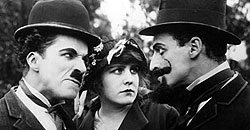A Jitney Elopement

With only his fifth Essanay film, Chaplin seemed to have run out of inspiration in A Jitney Elopement. It’s a mess on all counts.
And its first “count” is the main character, Count Chlorine de Lime (Leo White), who is meeting with a man (Ernest Van Pelt) to discuss his possible marriage to the man’s daughter (Edna Purviance), if the price is right. I don’t know how common this practice truly was back in the 1910’s, but in the movies at least, it was enough to quickly turn the count-impersonation bit into silent film comedy’s most overused cliché. (We haven’t even gotten to Chaplin’s Mutual short The Count yet.)
Edna has no desire to follow her father’s orders, especially since she already has a love of her own, who is…Charlie?? Think about this a minute: Charlie, the woebegotten loner with the tramp appearance who usually has to spend two reels wooing Edna, starts off here as the man she prefers over some rich count. How’d she meet this guy, from a personals ad in the Police Gazette?
Anyway, Edna informs Charlie of the plot, causing Charlie to “impersonate” the count when he is expected at dinner. And a very unfunny dinner it is, consisting mostly of Charlie pantomiming how undercooked the food is. Eventually the real count shows up, and Charlie is forcibly shown the door.
When the count takes Edna and her father out for a drive and then walks Edna through the park, who should they encounter but Charlie again. From there, the movie finishes off with a frantic chase that’s notable only as one of Chaplin’s few auto-race climaxes, in which the count and the father chase Charlie and Edna in separate cars. This seems a nice novelty at first, until a couple of cops (Bud Jamison and Carl Stockdale) are dragged in, and it slowly dawns on you that Chaplin is aiming for nothing more than a Keystone Kops-type ending – the type of thing you’d thought his move to Essanay would transcend.
Chaplin is so low on inspiration here, he even steals his final gag from the closing of The Champion.
Chaplin must have realized how derivative this movie was and decided to try something different next time around. His following movie was the one to leave its mark on his audiences, and on film history.
Click here to return to:
HomepageFilmography